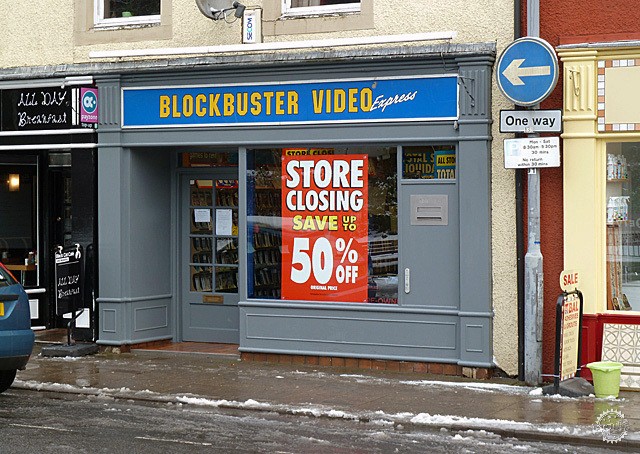
Corner Shop (2000). Image © Flickr user Andrea_44 licensed under CC BY 2.0
6种现代类型建筑将很快消失
6 Modern Building Types That Will Soon Disappear Forever
由专筑网缕夕,李韧编译
建筑在历史中成为一个地方的标志,反映了时代的时代精神。但是,我们如何在一个发展速度逐渐加快的世界中设计建筑,反思当下的环境,而有些建筑则在逐渐消失?在这里,我们围绕着现代的六种类型的建筑物展开话题,它们的出现速度与它们消失的速度一样快。而这些建筑物的消失,也许会成为人们怀旧情怀,也许也会记载进历史进程。
记忆与建筑紧密相连,Juhani Pallasmaa在他的作品《皮肤的眼睛》中描述了“身体会有记忆,建筑意义源于身体和感官的记忆。”下面的一些建筑已经过时,但在历史上它们却有着自己独特的价值,如果建筑不再具有社会功能,它们仍会被人们记住吗?
Architecture is often seen as something which provides a place-marker in history, reflecting the zeitgeist of an era. But how do we design architecture in a world that is changing faster than ever before, where entire types of buildings disappear seemingly in a flash? Here, we round up six types of buildings that came into existence in modern times and are fading as fast as they appeared. Mostly banal and previously ubiquitous, the nostalgia associated with the disappearance of these buildings taps into something emotional, rather than intellectual admiration.
Memory and architecture are closely linked, with Juhani Pallasmaa in his book The Eyes of the Skin describing how “the body knows and remembers. Architectural meaning derives from archaic responses and reactions remembered by the body and the senses.” Some of the structures below have become obsolete within half a lifespan—an interesting point to consider in a discipline that has historically valued permanence above all. If structures no longer serve a social function, will they be remembered?
街边小铺
Corner Stores

Milk Bar, West Footscray, Australia. Image © Flickr user Susan Fitzgerald licensed under CC BY-ND 2.0
街边小铺遍布世界各地,它有各种形态:纽约的酒窖、澳大利亚的牛奶酒吧、菲律宾的街边小店。它们都有一个共同点,那就是大多数人都有在这里有着美好的回忆,例如与家人聊天、储蓄零钱、买巧克力棒。20世纪40年代和50年代兴起纽约的酒窖,起源于大批移民从古巴、波多黎各和多米尼加共和国来到纽约。在澳大利亚,牛奶酒吧是郊区街角的常见建筑,澳大利亚夏季,街边有着一片让人感受凉爽的冰淇淋店。然而,随着购物中心和特许经营店的兴起,这些由家庭经营的街角商店营业额一直在急剧下滑。7-Elevens的便利店氛围与传统街角商店显得格格不入,因此这些街边小店正在被便利店逐渐取代。
Corner stores exist around the world, under a variety of names: New York's bodegas, Australia's milk bars, sari-sari stores in the Philippines. One thing they all have in common is that most people have fond memories associated with them, from chats with the family who run them, to saving up coins to buy a chocolate bar as a child. New York bodegas sprang up in the 1940s and 50s after waves of immigrants arrived in New York from Cuba, Puerto Rico, and the Dominican Republic. In Australia, the milk bar is a familiar sight on suburban street corners; an oasis stocked with ice-cream during the Australian summer. However, with the rise of shopping centers and franchises, the family-owned corner store has been on a sharp decline. Brightly-lit 7-Elevens have a vastly different atmosphere to the crowded messiness and individuality of the traditional corner store, touchstones of community that are fast disappearing.

East New York Deli (2007). Image © Flickr user Paul Lowry licensed under CC BY 2.0
电话亭
Phone Booths

UK Phone Booth . Image via Pixabay
似乎在一夜之间过时了。电话亭曾经是一个容易识别,且空间足够大、适合人们沟通的空间,它成为社会中不可分割的一部分,甚至在十年前也是遍布各地,但现在大多数电话亭都没有人再使用了。
我们所知道的第一款付费电话由William Gray于1889年设计,他创造了一个不需要服务员的投币式公用电话。公共电话亭于20世纪初开始建造,我们今天见到的玻璃和铝盒组成的电话亭流星于20世纪50年代。然而,随着手机的发展,电话亭的消失不可避免。约旦、比利时、丹麦、芬兰和瑞典等国家完全取消了付费电话,并且它们在全球范围内也逐渐取消中。一些城市已将它们转换为Wi-Fi热点,保留对建筑的使用。英国许多标志性的红色电话亭已经重新用于小咖啡馆、手机维修店甚至是除颤器。
From Doctor Who to Superman, and even the cliche of the pay phone that mysteriously rings by itself—the phone booth is a profound cultural artifact that became obsolete seemingly overnight. Easily recognizable and just large enough to fit a person and a phone, booths were such a ubiquitous part of society that not even a decade ago many still existed, littered across cities but mostly unused.
The first pay phone as we know it was designed in 1889 by William Gray, who created a coin-operated public telephone that did not need an attendant. Public phone booths began to be built in the early 1900s, and the glass and aluminum boxes we know today became popular in the 1950s. However, with the rise of the mobile phone, the end of phone booths was inevitable. Jordan, Belgium, Denmark, Finland, and Sweden have eliminated pay phones altogether, and they continue to decline across the world. Some cities have converted them into wi-fi hotspots to retain use for the structures. Many of the iconic red phone booths in Britain have been repurposed into tiny cafes, mobile phone repair shops, or even defibrillator machines by a generation that refuses to let go.
影碟租赁商店
Video Rental Stores

Closing down sale at Blockbuster Video, Bank Street, Galashiels. Image © Walter Baxter licensed under CC BY-SA 2.0
十年前,如果你想免费住一晚,当地的影碟租赁商店会是你很好的选择。“Netflix和chill”已经关闭很多年了,所以如果你想要度过一个夜晚,那么只能选择其他方式了。VHS、DVD和Blu-Ray已经是旧时代的产物,取而代之的是一系列全新的流媒体服务,影碟租赁商店因此显得没有什么存在意义。在澳大利亚,超过95%的商店现已关闭,随后有数千个专门建造的商店荒废其中。在美国为数不多的Blockbuster视频商店中,有三家位于阿拉斯加的商店,因为当地寒冷的冬天和较慢的互联网网速,使影碟租赁服务还有生存的空间,还有一家位于俄勒冈州波特兰市郊的商店,由于当地客户认为它比Netflix或其他流媒体网站更“个性化”,商店才得以幸存。
Ten years ago, if you wanted to spend a night in, the local video store was your first stop. "Netflix and chill" was years away, so if you wanted a good night, it was time to rewind the VHS and hit play. VHS, DVDs, and Blu-Ray came and went in one generation, and in their place have sprung a crop of new streaming services, rendering the physical space obsolete. In Australia, over 95% of these stores are now closed, leaving in their wake thousands of purpose-built outlets, rotting in the suburban landscape. Among the few remaining Blockbuster video stores in the United States are three stores in Alaska, where cold winters and slower internet connections make video rental more appealing; and one store that lies three hours outside of Portland, Oregon, its existence owing to the fact that local customers see it as more “personal” than Netflix or other streaming sites.
服务站
Service Stations

Valley Heights Shell Service Station, Now Demolished (1983). Image © Blue Mountains Library, Local Studies licensed under CC BY-SA 2.0
在过去的一百多年来,加油站一直附设便利商店、维修和保养的中心,以及企业的小办公室。 不仅如此,无处不在的加油站,从城市街区到州际公路,都是汽车革命的象征。它们宽阔的檐篷充当广告牌,通常采用优雅的线条和小型结构支撑,给人失重感。随着建筑环境的不断开发,留下看似不可磨灭的印记,零售商经常调整其设计方式,从而更贴近周围社区的服务需求。然而,天然气的使用量减少,土地成本飙升,许多店主都在出售商店。由于占地面积大,缺乏现有开发空间,加油站便成为翻新改造的好选择,例如许多相关设施都被改造成艺术画廊、办公空间和餐馆。
For over a hundred years, the local gas station has acted as a retailer of convenience, a hub for repairs and upkeep, and a corporate standard. More than that though, the ubiquitous gas station, seen from city blocks to isolated interstates, was a symbol of the automotive revolution. Their broad canopies acted as billboards and often included gracefully sweeping lines and minimal supports—giving the impression of weightlessness. The accompanying pumps and wide bays left a seemingly-indelible imprint on the built environment, with retailers often modulating their designs to complement the community around them. However, as gas usage has decreased, and the cost of land has skyrocketed, many station owners are selling up shop. With their large footprint and lack of existing development, gas stations have become attractive prospects for redevelopment, with former stations now serving as art galleries, office spaces, and restaurants.

Kerry's Service Station, Blackheath (1983). Image © Blue Mountains Library, Local Studies licensed under CC BY-SA 2.0
报摊
Newsstands

Newsstand at Third & Pike (1946). Image © Seattle Municipal Archives licensed under CC BY 2.0
报摊曾经是城市街道的中流砥柱,它具有明确的目的性。头条新闻总是报摊的灵魂所在,即使人们从未读过今天的报纸,但也能让人们之间保持联系。报摊以最小的成本为企业家提供了发展的机会。在这里,许多移民和退伍军人整天都像哨兵一样坐着,兜售新闻和糖果。这些人可能从未设想过这样一个世界,这些小型、个性化的木材或钢材建筑装置,将会被数字化所取代。随着摊位的标准化进程,纽约市安装了数千个相同的金属和玻璃结构,从而取代了传统的供应商。
Once a mainstay of the city street, newsstands were structures with a clear purpose. The headlines screamed out to passers-by, keeping people connected even if they never read a paper. With minimal setup costs, newsstands provided entrepreneurs with a chance at upward mobility. Here, many immigrants and military veterans sat like sentinels all day long, hawking the news and a candy bar. Such people likely never envisaged a world where their small, individualized stores of wood or steel would be practically digitized. The stands that remain are increasingly standardized, with NYC installing thousands of identical metal-and-glass structures to replace traditional vendors.

Newsstand at Night, NYC (1980). Image© Flickr user Jlm Ronan licensed under CC BY-SA 2.0
自助照相馆
Photo Booths

via Pixabay
老实说,我们都看到过某个人的Facebook发出这些老式摄影棚信息。然而,摄影作为派对的一大主角,其历史课追溯至很久以前。自20世纪60年代以来,自助照相馆让我们真正远离了摄影师的镜头。虽然这只是一个小盒子,但它们在购物中心或火车站的一角,可以让人们有独立的空间进行照相留念。这些照相馆捕获了许多温暖的时刻,当然,也可以用于护照照片的拍摄。
Let’s be honest: we’ve all seen someone’s Facebook post of a silly photobooth strip and rolled our eyes. However, this modern usage of photography as a novelty for parties and functions belies a rich history of portraiture dating back over a century. Since the 1960s, automated booths have allowed us to truly be ourselves away from judging eyes. Although the structure was simply a tiny box, they were spaces in shopping malls or train stations that allowed intimate narratives to unfold. These booths, and the photographs they represent captured many tender moments in time... and the occasional passport photo.

Photobooth photos. Image © Flickr user simpleinsomnia licensed under CC BY 2.0
|
|
